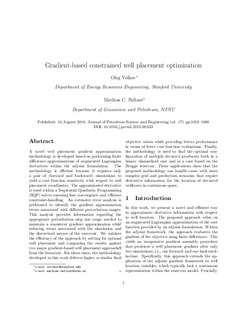| dc.contributor.author | Volkov, Oleg | |
| dc.contributor.author | Bellout, Mathias | |
| dc.date.accessioned | 2019-08-08T08:12:39Z | |
| dc.date.available | 2019-08-08T08:12:39Z | |
| dc.date.created | 2018-11-29T15:35:07Z | |
| dc.date.issued | 2018 | |
| dc.identifier.citation | Journal of Petroleum Science and Engineering. 2018, 171 1052-1066. | nb_NO |
| dc.identifier.issn | 0920-4105 | |
| dc.identifier.uri | http://hdl.handle.net/11250/2607512 | |
| dc.description.abstract | A novel well placement gradient approximation methodology is developed based on performing finite difference approximations of augmented Lagrangian derivatives within the adjoint formulation. The methodology is efficient because it requires only a pair of (forward and backward) simulations to yield a cost function sensitivity with respect to well placement coordinates. The approximated derivative is used within a Sequential Quadratic Programming (SQP) solver ensuring fast convergence and efficient constraint-handling. An extensive error analysis is performed to identify the gradient approximation errors associated with different perturbation ranges. This analysis provides information regarding the appropriate perturbation step size range needed to maintain a consistent gradient approximation while reducing errors associated with the simulation and the discretized nature of the reservoir. We validate the efficiency of the approach by solving for optimal well placement and comparing the results against two major gradient-based well placement approaches from the literature. For these cases, the methodology developed in this work delivers higher or similar final objective values while providing better performance in terms of fewer cost function evaluations. Finally, the methodology is used to find the optimal configuration of multiple deviated producers both in a binary channelized case and in a case based on the Brugge reservoir. These applications show that the proposed methodology can handle cases with more complex grid and production scenarios that require derivative information for the location of deviated wellbores in continuous space. | nb_NO |
| dc.language.iso | eng | nb_NO |
| dc.publisher | Elsevier | nb_NO |
| dc.rights | Attribution-NonCommercial-NoDerivatives 4.0 Internasjonal | * |
| dc.rights.uri | http://creativecommons.org/licenses/by-nc-nd/4.0/deed.no | * |
| dc.title | Gradient-based constrained well placement optimization | nb_NO |
| dc.type | Journal article | nb_NO |
| dc.type | Peer reviewed | nb_NO |
| dc.description.version | acceptedVersion | nb_NO |
| dc.source.pagenumber | 1052-1066 | nb_NO |
| dc.source.volume | 171 | nb_NO |
| dc.source.journal | Journal of Petroleum Science and Engineering | nb_NO |
| dc.identifier.doi | 10.1016/j.petrol.2018.08.033 | |
| dc.identifier.cristin | 1637094 | |
| dc.description.localcode | © 2018. This is the authors’ accepted and refereed manuscript to the article. Locked until 16.8.2020 due to copyright restrictions. This manuscript version is made available under the CC-BY-NC-ND 4.0 license http://creativecommons.org/licenses/by-nc-nd/4.0/ | nb_NO |
| cristin.unitcode | 194,64,90,0 | |
| cristin.unitname | Institutt for geovitenskap og petroleum | |
| cristin.ispublished | true | |
| cristin.fulltext | preprint | |
| cristin.qualitycode | 2 | |

